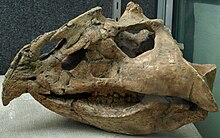Bayan Mandahu Formation
| Bayan Mandahu Formation | |
|---|---|
| Stratigraphic range: Campanian, | |
| Type | Geological formation |
| Lithology | |
| Primary | Sandstone |
| Location | |
| Region | Asia |
| Country | |
| Type section | |
| Named for | Bayan Mandahu, Inner Mongolia |
The Bayan Mandahu Formation (or Wulansuhai Formation) is a geological unit of "redbeds" located near the village of Bayan Mandahu in Inner Mongolia, China Asia (Gobi Desert) and dates from the late Cretaceous Period. Laid down in the Campanian, it is dated somewhat uncertainly to between 75-71 mya (million years ago).[1]
The paleoenvironment it preserves was semi-arid and characterized by alluvial (stream-deposited) and eolian (wind-deposited) sediments. The formation is known for its vertebrate fossils, most of which are preserved in unstructured sandstone, indicating burial by wind-blown sandstorms.[2]
Fauna
The fauna of the Bayan Mandahu is very similar in composition to the nearby Djadochta Formation, and the two may have been deposited at roughly the same time. These two formations share many of the same genera, but differ in the makeup of species. For example, the most common mammal in the Djadochta is Kryptobaatar dashzevegi, while in the Bayan Mandahu, it is the closely related Kryptobaatar mandahuensis. Similarly, the dinosaur fauna of the Djadochta includes Protoceratops andrewsi and Velociraptor mongoliensis, while the Bayan Mandahu contains Protoceratops hellenikorhinus and Velociraptor osmolskae.[1]
Crocodylomorphs
| Crocodylomorphs of the Bayan Mandahu Formation | ||||||
|---|---|---|---|---|---|---|
| Genus | Species | Location | Stratigraphic position | Abundance | Notes | |
| A mesoeucrocodylian. | ||||||
Lizards
An amphisbaenian species is known from the formation.[2] An iguanian species is known from the formation.[2]
| Lizards of the Bayan Mandahu Formation | ||||||
|---|---|---|---|---|---|---|
| Genus | Species | Location | Stratigraphic position | Abundance | Notes | |
|
A. magnidentatus[2] |
An agamid. | |||||
|
A diploglossan. | ||||||
Mammals
A taeniolabidoidea multituberculate is known from the formation.[2]
| Mammals of the Bayan Mandahu Formation | ||||||
|---|---|---|---|---|---|---|
| Genus | Species | Location | Stratigraphic position | Abundance | Notes | |
|
K. gobiensis[2] |
A placental. Also present in the Djadochta Formation. | |||||
|
K. mandahuensis |
The most common mammal in this formation.[1] |
|||||
Ornithischians
| Ornithischian dinosaurs of the Bayan Mandahu Formation | ||||||
|---|---|---|---|---|---|---|
| Genus | Species | Location | Abundance | Notes | Images | |
|
Hadrosauridae indet.[3] |
Indeterminate[3] |
|
A hadrosaurid. |
  | ||
|
M. dodsoni[1] |
|
A ceratopsian. | ||||
|
P. mephistocephalus[1] |
|
"Skull, postcranial skeleton, osteoderms."[4] |
An ankylosaur. | |||
|
P. hellenikorhinus[1] |
|
"Complete skull."[5] |
A ceratopsian. | |||
|
Indeterminate[2] |
|
A giant ceratopsian. | ||||
Saurischians
| Saurischian dinosaurs of the Bayan Mandahu Formation | ||||||
|---|---|---|---|---|---|---|
| Genus | Species | Location | Abundance | Notes | Images | |
|
cf. Gobipteryx[2] |
Indeterminate |
Eggs similar to those attributed to Gobipteryx minuta from the Djadochta Formation. |
||||
|
L. exquisitus[6] |
|
A dromaeosaurid | ||||
|
L. tani[7] |
|
A troodontid | ||||
|
P. curriei |
|
A troodontid | ||||
|
W. gobiensis |
|
|||||
|
L. monodactylus |
|
|||||
|
M. leptonychus |
|
An oviraptorid | ||||
|
Oviraptoridae indet.[3] |
Indeterminate[3] |
|
An oviraptorid. | |||
|
Indeterminate[3] |
|
A sauropod. | ||||
|
Tyrannosauridae indet.[3] |
Indeterminate[3] |
|
A tyrannosaurid. | |||
|
V. mongoliensis[2] |
Misclassified, only present in the Djadochta Formation. | |||||
|
V. osmolskae |
|
A dromaeosaurid. | ||||
Turtles
| Turtles of the Bayan Mandahu Formation | ||||||
|---|---|---|---|---|---|---|
| Genus | Species | Location | Stratigraphic position | Abundance | Notes | |
See also
- Barun Goyot Formation
- List of fossil sites (with link directory)
- Nemegt Formation
- List of dinosaur-bearing rock formations
References
- ^ a b c d e f g h i Godefroit, Pascal; Currie, Philip J.; Li, Hong; Shang, Chang Yong; Dong, Zhi-ming (2008). "A new species of Velociraptor (Dinosauria: Dromaeosauridae) from the Upper Cretaceous of northern China". Journal of Vertebrate Paleontology. 28 (2): 432–438. doi:10.1671/0272-4634(2008)28[432:ANSOVD]2.0.CO;2. Cite error: The named reference "PGetal2008" was defined multiple times with different content (see the help page).
- ^ a b c d e f g h i j k l m n o p q Jerzykiewicz, T.; Currie, P.J.; Eberth, D.A.; Johnston, P.A.; Koster, E.H.; Zheng J. (1993). "Djadokhta correlative strata in Chinese Inner Mongolia: An overview of the stratigraphy, sedimentary geology, and paleontology and comparisons with the type locality in the pre-Altai Gobi". Canadian Journal of Earth Sciences. 30: 2180–2195. doi:10.1139/e93-190. [printed early 1994]
- ^ a b c d e f g h i j k l m n o p q r s Nicholas R. Longrich, Philip J. Currie, Dong Zhi-Ming (2010). "A new oviraptorid (Dinosauria: Theropoda) from the Upper Cretaceous of Bayan Mandahu, Inner Mongolia". Palaeontology. 53 (5): 945–960. doi:10.1111/j.1475-4983.2010.00968.x.
{{cite journal}}: CS1 maint: multiple names: authors list (link) - ^ "Table 17.1," in Weishampel, et al. (2004). Page 364.
- ^ "Table 22.1," in Weishampel, et al. (2004). Page 480.
- ^ a b Xu, X., Choinere, J., Pittman, M., Tan, Q., Xiao, D., Li, Z., Tan, L., Clark, J., Norell, M., Hone, D.W.E. and Sullivan, C. (In press). "A new dromaeosaurid (Dinosauria: Theropoda) from the Upper Cretaceous Wulansuhai Formation of Inner Mongolia, China." Zootaxa, in press.
- ^ a b c Xu X., Tan Q., Sullivan, C., Han F., Xiao D. (2011) A Short-Armed Troodontid Dinosaur from the Upper Cretaceous of Inner Mongolia and Its Implications for Troodontid Evolution. PLoS ONE 6(9): e22916. doi:10.1371/journal.pone.0022916 http://www.plosone.org/article/info%3Adoi%2F10.1371%2Fjournal.pone.0022916
